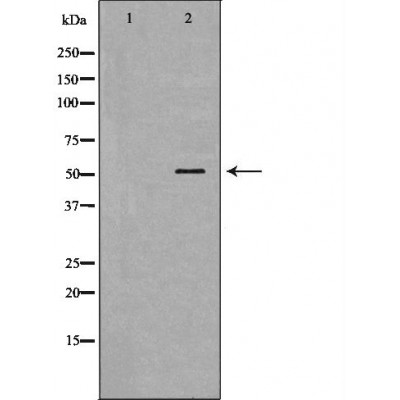BPI Antibody - #DF7282
| Product: | BPI Antibody |
| Catalog: | DF7282 |
| Description: | Rabbit polyclonal antibody to BPI |
| Application: | WB IHC |
| Reactivity: | Human, Rat |
| Mol.Wt.: | 54kDa; 54kD(Calculated). |
| Uniprot: | P17213 |
| RRID: | AB_2839221 |
Related Downloads
Protocols
Product Info
*The optimal dilutions should be determined by the end user.
*Tips:
WB: For western blot detection of denatured protein samples. IHC: For immunohistochemical detection of paraffin sections (IHC-p) or frozen sections (IHC-f) of tissue samples. IF/ICC: For immunofluorescence detection of cell samples. ELISA(peptide): For ELISA detection of antigenic peptide.
Cite Format: Affinity Biosciences Cat# DF7282, RRID:AB_2839221.
Fold/Unfold
Bactericidal permeability-increasing protein; bactericidal/permeability-increasing protein; BPI; BPI fold containing family D, member 1; BPIFD1; CAP 57; rBPI; recombinant BPI holoprotein, rBPI;
Immunogens
- P17213 BPI_HUMAN:
- Protein BLAST With
- NCBI/
- ExPASy/
- Uniprot
MRENMARGPCNAPRWASLMVLVAIGTAVTAAVNPGVVVRISQKGLDYASQQGTAALQKELKRIKIPDYSDSFKIKHLGKGHYSFYSMDIREFQLPSSQISMVPNVGLKFSISNANIKISGKWKAQKRFLKMSGNFDLSIEGMSISADLKLGSNPTSGKPTITCSSCSSHINSVHVHISKSKVGWLIQLFHKKIESALRNKMNSQVCEKVTNSVSSELQPYFQTLPVMTKIDSVAGINYGLVAPPATTAETLDVQMKGEFYSENHHNPPPFAPPVMEFPAAHDRMVYLGLSDYFFNTAGLVYQEAGVLKMTLRDDMIPKESKFRLTTKFFGTFLPEVAKKFPNMKIQIHVSASTPPHLSVQPTGLTFYPAVDVQAFAVLPNSSLASLFLIGMHTTGSMEVSAESNRLVGELKLDRLLLELKHSNIGPFPVELLQDIMNYIVPILVLPRVNEKLQKGFPLPTPARVQLYNVVLQPHQNFLLFGADVVYK
PTMs - P17213 As Substrate
| Site | PTM Type | Enzyme | Source |
|---|---|---|---|
| K327 | Acetylation | Uniprot | |
| T394 | Phosphorylation | Uniprot | |
| S403 | Phosphorylation | Uniprot | |
| K454 | Ubiquitination | Uniprot |
Research Backgrounds
The cytotoxic action of BPI is limited to many species of Gram-negative bacteria; this specificity may be explained by a strong affinity of the very basic N-terminal half for the negatively charged lipopolysaccharides that are unique to the Gram-negative bacterial outer envelope. Has antibacterial activity against the Gram-negative bacterium P.aeruginosa, this activity is inhibited by LPS from P.aeruginosa.
Secreted. Cytoplasmic granule membrane.
Note: Membrane-associated in polymorphonuclear Leukocytes (PMN) granules.
Restricted to cells of the myeloid series.
Monomer. Homodimer; disulfide-linked.
The N-terminal region may be exposed to the interior of the granule, whereas the C-terminal portion may be embedded in the membrane. During phagocytosis and degranulation, proteases may be released and activated and cleave BPI at the junction of the N- and C-terminal portions of the molecule, providing controlled release of the N-terminal antibacterial fragment when bacteria are ingested.
The N- and C-terminal barrels adopt an identical fold despite having only 13% of conserved residues.
Belongs to the BPI/LBP/Plunc superfamily. BPI/LBP family.
Restrictive clause
Affinity Biosciences tests all products strictly. Citations are provided as a resource for additional applications that have not been validated by Affinity Biosciences. Please choose the appropriate format for each application and consult Materials and Methods sections for additional details about the use of any product in these publications.
For Research Use Only.
Not for use in diagnostic or therapeutic procedures. Not for resale. Not for distribution without written consent. Affinity Biosciences will not be held responsible for patent infringement or other violations that may occur with the use of our products. Affinity Biosciences, Affinity Biosciences Logo and all other trademarks are the property of Affinity Biosciences LTD.
